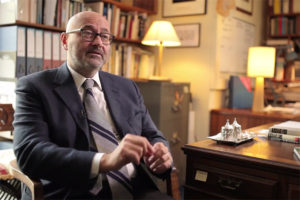Social Сondenser and Socialist Urban Planning
Social anthropologist Michal Murawski on the soviet constructivism in architecture, the origins of the concept...
The role of science in the field of art has increased dramatically over the 20th century and especially in the last 10 years, as the New York art market has been rocked by a series of forgery scandals where huge amounts of money have been lost because of forgeries and where it’s become ever more clear that science needs to play a role in determining correct attribution and detecting art forgeries. This is what we do in our laboratory that we call New York Art Forensics, which I and my business partner Thiago Piwowarczyk operate in Brooklyn, New York. What we do in our laboratory is analyze artworks, especially paintings, and develop a material analysis report which will allow the owner of the artwork to have insight and understanding, especially as to whether the artwork is by a very famous artist or by someone else, for example, an art forger.
What we do in that process is a series of steps using a number of different scientific tools to develop this conclusion. We start with documentation, and documentation techniques use different types of light to make photographs of the painting or the artwork. We start with normal light, visible light, the spectrum of light that our eyes can see, and we use very powerful light, and we use it often not just straight at the painting, but we use it, for example, in what we call raking light which is where we put the light to the side of the artwork, and you can see the light moving across it. That will allow us to see depths and patterns, kind of the three-dimensional surface of the artwork. We put light behind the painting, what we call transmission light, so we put the light moving through the painting.
We also use, for example, the other end of the spectrum, the infrared spectrum, which is wavelengths longer than what the eye can see. We have a special kind of camera that can capture infrared light. Infrared can actually pass through the painting and actually show us what’s underneath the paint, particularly if we have a drawing if an artist has made sketches with a pencil or charcoal underneath the paint to lay out their plan and then paint it on top of it, so we can see those things. Also, we can use X-rays, which again is like a medical X-ray, and we can look beyond the paint, or we can look to the under layers of painting, especially in an older painting, if we have underpainting that was done in heavy metals (lead, arsenic, mercury), those images will show up.
Once we have documented the artwork, then we move on to material analysis, a real chemical analysis of what the materials are here.
We’re specifically looking at the paint, and the paint is composed generally of two things: a pigment that gives its color and a binder that holds it together. We would analyze both of those, and often we will analyze what we call the support, what the painting has been made on, whether it’s canvas or wood or cardboard: we’ll sometimes analyze that material too.
When we analyze these, we use a couple of different devices. The first one we usually use is called an x-ray fluorescence gun, and it looks like a Star Trek phaser: it kind of looks a bit like a gun, and it’s very handy. It’s a relatively new device; they’ve only been around for about 10 years, and they’re really handy for the art world because they’re non-destructive, so we don’t have to take a sample from the paint at all; we just put it right next to the painting or anything else we’re testing, a statue or anything else. We can immediately get a reading on what elements are present.
This works really well for older paints. Old paints tend to be what we would call inorganic because they’re based on minerals: rocks and metals. Lead, zinc, chrome, cobalt, titanium, tin, and many other common metals will be found in there. The x-ray fluorescence gun is really great for identifying these elements, and for older paints, it works really well, and we can really know, especially when we compare what we know from the elements and when we consider what we know about the history of paint and when certain pigments might have been available.
So up until the 19th century there’s really just a small number of paints that are available, paints based on iron like ochres, yellows that are lead and tin, white that’s lead, reds that come from mercury, orange and yellows that come from arsenic, and it’s quite simple. Starting in the 19th century we began to invent new paints based in chrome, and cobalt, and cadmium and other metals, and if we found those paints in a painting that in theory was from the 1600s, we would know that it’s probably a forgery or a later day copy.
That works great up until the 20th century. The last really important development in the field of what we would say inorganic paints would be the very important point that we call titanium white based on titanium dioxide. That paint is understood to have entered production and distribution (and that’s really the key, determining when it was distributed and when an artist could have gotten this paint) at the date of 1921. Titanium is really easy to detect with our device, and it often helps us to solve our biggest problems with art forgeries because so many artists who are worth a lot of money today – Monet, Renoir, Degas, Modigliani – would all die before 1921 and therefore we can assume with great confidence that they never had titanium in their paintings. So if we do find titanium, it’s very quickly we can determine that this is not by them; it’s by someone else.

It becomes more complex as we move through the 20th century because we’ve also developed paints that are organic or, I would say, synthetic organic. We’ve always had organic paints as well; we might call them dyes. These are colourants that come from plants and animals, so they’re carbon-based organic molecules. For example, the madder plant is a source of red, indigo is a plant that produces blue, saffron is a plant that produces yellow, the cochineal beetle is an insect that produces a type of red, and they would be organic molecules, so they would be complex combinations of carbon and hydrogen and nitrogen, and our x-ray fluorescent gun is not going to work to detect those.
More importantly, starting in the 19th century, we first saw our first what we call synthetic organic. That’s a paint that is created in a laboratory, often using carbon-based material (coal tar, oil) and then synthetically creating a molecule that resembles a molecule we find in nature but that we can produce in very large amounts. The first one of these is a pigment that we call alizarin, which is a molecular copy of the molecule we find in the madder plant, and it allowed us to produce red dyes and pigments in massive quantities and very cheaply. It really changed the paint and dye industries because it was so cheap, and for most of the 20th century, the developments of new paints will continue to be in that sector, in the synthetic organic form.
And really after titanium that would be the last inorganic important development, all the rest of the developments now through the rest of 20th century are in this field of synthetic organics in which case we need different devices to test them.
For that, we use two devices: they’re much larger machines, and they do require that we take what we can call a micro-destructive sample, so we will use a scalpel and take a small scraping of paint. You would never notice that we’d done that to the painting, but we do have to take a small amount of material to do those kinds of tests. We use, for example, two different devices: one is called a Fourier transform infrared, which involves using infrared light, and the other one we call Raman spectroscopy, which uses lasers.
So our devices will give us a reading on what is the molecular structure of that paint, and then we can compare it with the records.
Especially in the 20th century we start to have real noted patents where a paint firm or a laboratory has developed a new pigment and they’re going to get a patent for it. So we can see those records of patents, and that gives us clear markers of when a paint could possibly have been available, and we use that to compare with what we find in the painting that we’re studying.
We frequently will find that although, in theory, this is a painting by Jackson Pollock, in fact, the pigment that was in it was not patented until 1980, long after he was dead, in which case we know this is a forgery.
The same analysis we do for what we call the binders, the things that hold the paint together, whether that’s oil in oil painting, which is what most paintings in the 19th and early 20th century would be but later in the 20th century developed new binders. Pollock used house paint, which was composed of a totally different binder. Later in the 20th century, we have the binders we call acrylics, which are almost something like plastics holding the paint together. And if we know when different binders were developed, we compare that with the ones that we find, and again, we’ve had Jackson Pollock cases where the binder is acrylic, and Pollock is not believed to have ever used acrylic paints. So we know that, again, that would be an indication that this is a forgery.
So with those techniques and with all of that knowledge – knowing the elemental materials, knowing the molecular structure and all of the documentation that we have from different forms of light – we’re able to form a conclusion usually about this central question: could this artwork have been by a certain artist?
At the end of our report, we state that conclusion based on our material analysis.

Social anthropologist Michal Murawski on the soviet constructivism in architecture, the origins of the concept...

Historian Alessandro Scafi on the four rivers of paradise, Calvin's mapping of Eden, and the first attempts to...

Evolutionary biologist Armand Leroi on the division into natural sciences and humanities, how to read art usin...